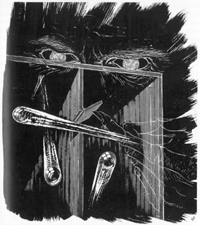

Thomas Pynchon achieves an unusual synthesis of art and science, and develops the unique character of his ambitious, "post-modern" works with a renaissance conception of continuous knowledge. Engineering principals animate his fiction in literal explorations, and then escalate into larger thematic matter. The Crying of Lot 49 (1965) traces Entropy through the theoretical Maxwell's Demon device (the greatest historical challenge to the second law of thermodynamics), and also extends the property and Demon to metaphorically control and inform the journey of Oedipa Mass. Pynchon's reader travels an analogous odyssey to the protagonist, sorting information, flirting with chaos and circumnavigating truth.
There are two fields which define this concept:
Thermodynamics is the science of the relations between heat and other forms of energy. It deals with the changes that occur in a system if the energy distribution is unbalanced, therefore it "can be regarded as governing the direction of all physical changes taking place in the universe. With time, the energy within a system will inevitably tend to become distributed in the most probable pattern, which consists of all the individual particles of the system engaging in random, disordered motion" (OED). Thermodynamic entropy is the measure of this disorganization in a system. Furthermore, this "most probable pattern" is actually a state of equal energy among particles, as collisions cause bodies to exchange heat. A closed system inevitably proceeds toward uniformity of energy.
Information Theory is the mathematical theory of communication that is used to find out the speed and quantity of information transmission. It uses statistical concepts of probability to compute the extra information (redundancy) necessary to counteract the distortion and losses that may occur during transmission from one information source to another. Entropy within this theory is the "measure of the rate of transfer of information in [that] message" (OED). For a specific examination of information entropy in COL 49, see "The Paradox of Truth, the Truth of Entropy"
"Nevertheless," continued Callisto, "he found in entropy or the measure of disorganization for a closed system an adequate metaphor to apply to a certain phenomena in his own world. He saw, for example, the younger generation responding to Madison Avenue with the same spleen his own had once reserved for Wall Street: and in American 'consumerism' discovered a similar tendency from the least to most probable, from differentiation to sameness, from ordered individuality to a kind of chaos. He found himself, in short, restating Gibbs' prediction in social terms, and envisioned a heat-death for his culture in which ideas, like heat-energy, would no longer be transferred, since each point in it would ultimately have the same quantity of energy; and intellectual motion would, accordingly, cease." (Slow Learner, 88-89)Here Pynchon invokes the concept of "heat-death," where energy is no longer exchanged between particles which have reached the most probable state in a closed system (predicted by Willard Gibbs). Callisto looks at this stagnation and foresees a similar destiny for ideas. Today, with increased travel of information and capitalist consumerism across the planet's CNS (Marshall McLuhan's term), many prophesize an analogous "global monoculture" as a final state of sameness. In COL 49, Pynchon explicitly revisits entropy and adds a manifestation of its greatest theoretical challenger.
In Maxwell's original conception, his creature operates a sliding door
between two sealed spaces which start off containing gas at equal
temperature and pressure. The speed of any given molecule is random, but
all of the molecules in a system are distributed by velocity such that the
average speed of the molecules is proportional to the square root of the
measurable temperature of the system. Consequently Maxwell's microscopic,
intelligent being can identify the relative representational temperatures of
molecules by their speeds. He (the being has been historically referred to
with the masculine pronoun) thus allows higher energy molecules to pass into
Room B, and lower energy ones to pass into Room A, through nimble operation
of his door as shown in the above illustrations (from ibid., 110; also see the graphic used in the logo of the New Mexico Chapter of the American Vacuum Society, featuring a demon in a bell jar). This
action heats Room B and cools Room A without the input of any work, and
appears to violate the second law of thermodynamics (for an experiential demonstration, try playing the Maxwell's Demon game in shockwave).
Richard Einhorn (pictured below), a prominent New York composer and producer, pays homage to the Demon in a four movement piece completed in 1990. This aural interpretation, written for five-string electric violin, captures the frenzy of sorting with wild percussive sounds and rhythms. Maxwell's Demon #1-4 premiered in Lincoln Center in 1990, and was then adapted for the1994 Ulysses Dove ballet, "Red Angels."
 "Maxwell's Demon #4" 655k - a 1 minute excerpt .AIFF sound file. Performance by Mary Rowell. Copyright c 1988, 1990 by Richard Einhorn. All Rights Reserved. Richard Einhorn Music (ASCAP).
"Maxwell's Demon #4" 655k - a 1 minute excerpt .AIFF sound file. Performance by Mary Rowell. Copyright c 1988, 1990 by Richard Einhorn. All Rights Reserved. Richard Einhorn Music (ASCAP).
"Red Angels," the NYC Ballet Company production.
Another consequence of the second law of thermodynamics, is that the entropy, or disorder, of the universe must increase for a reaction or event to occur (thus over time the universe proceeds toward the most probable state--hypothetically a "heat-death" of complete uniformity as mentioned by Pynchon in "Entropy"). The deviltry of Maxwell's being appears to cause an increase of order as molecules are sorted, thus decreasing the entropy of the gas with no apparent equalizing change to increase entropy for the universe. In reaction to these ideas, "The 'being' soon came to be called Maxwell's Demon, because of its far-reaching subversive effects on the natural order of things" ("Demons, Engines and the Second Law," 108). (shown in illustration below from: Hawkins, David. The Language of Nature. San Francisco: W.H.Freeman and Company, 1964).

In COL 49 Oedipa Maas tours the Yoyodyne plant, attempting to sort out Pierce Inverarity's will, and happens upon an employee named Stanley Koteks. This encounter introduces the concept of Maxwell's Demon, as Koteks explains to her that the creature sorts out "the fast molecules from the slow ones," and concentrates them to form a region of high temperature which could be harnessed against a cooler region to drive a heat engine. He continues: "Since the Demon only sat and sorted you wouldn't have to put any real work into the system. So you would be violating the second law of thermodynamics, getting something for nothing, causing perpetual motion" (86). Pynchon's protagonist responds comically, but precisely predicts the central problem with the Demon: "'Sorting isn't work?'" Oedipa said. "Tell them down at the post office, you'll find yourself in a mailbag headed for Fairbanks, Alaska, without even a FRAGILE sticker going for you.'" Koteks defends the device: "It's mental work, but not work in the thermodynamic sense." The challenge looms: can the Demon do entropy-free mental work? Oedipa must visit John Nefastis, inventor of the Machine that Koteks describes, to light this issue further.
Furthermore, a lesser known consequence of the second law discovered by Gustav Kirchhoff in 1859 is that, "It is impossible to see anything in a vessel at uniform temperature by the light of the vessel's own glow" ("Demons, Engines and the Second Law," 113). This makes sense, because if objects in a vessel had different surface intensities, energy would flow have to between them (as it does not) to equalize these inequalities. The Demon would need something akin to a flashlight to observe molecules.
One design in particular which overcomes the necessity of having an animate
Demon or expending energy in detecting molecules, is based on the Szilard
Engine in which a single molecule moves pistons to capture its energy,
conceived by Leo Szilard in 1929 (pictured below in an image from theBox of Demons page).

This invention is further improved by Charles H. Bennett not to observe a molecule at all, but to gain information on which of two spaces it occupies by the pressure it creates in that space (ibid., 114). Thus a fully mechanical engine design exists which appears to have the capacity to violate the second law independently of the above mentioned complaints.
For it was now like walking among matrices of a great digital computer, the zeroes and ones twinned above, hanging like balanced mobiles right and left, ahead, thick, maybe endless. Behind the hieroglyphic streets there would either be a transcendent meaning, or only the earth. In the songs Miles, Dean, Serge and Leonard sang was either some fraction of the truth's numinous beauty (as Mucho now believed) or only a power spectrum. Tremaine the Swastika Salesman's reprieve from holocaust was either an injustice, or the absence of wind; the bones of the GI's at the bottom of Lake Inverarity were there either for a reason that mattered to the world, or for skin divers and cigarette smokers. Ones and zeroes. . . . Either Oedipa in the orbiting ecstasy of a true paranoia, or a real Tristero. (181-182)The sheer number of sorting tasks "unforrows" Oedipa's mind. She cannot process all of the possibilities adequately, and consequently is deeply lost. The most fundamental analysis of information is the division between signal and noise. Like Oedipa in her bizarre encounters, the reader must determine which pieces of text are significant to his or her interpretation of the novel and its mysteries (and may thus feel a good deal of sympathy for Oed. when TP announces that, lost by the act of metaphor, she "did not know where she was, " 129). Human memory is finite, so some information must be discarded in the sorting of the novel.
The ultimate problem of the final Bennett design (as described above) touches on the relatively new field of information theory. A Demon could not have an infinite memory, so records must eventually be forgotten or somehow deleted. The breakdown of any post-demon storage mechanism (like a single binary computer switch), comes in the liability of information: specifically the liability of each previous record of whether the molecule was in Room A or B. Erasing this record, is a thermodynamically irreversible process which increases the entropy of the hardware or switch used to keep record. This physical step generates entropy in the form of heat which cancels out the loss of entropy achieved in the first place. These engines cannot fundamentally violate the second law. The Demon's mental activity is work in the information theory sense. Pynchon explains the agreement of the Demon style engines with the laws of thermodynamics in COL 49: "As the Demon sat and sorted his molecules into hot and cold, the system was said to lose entropy. But somehow the loss was offset by the information the Demon gained about what molecules were where" (105).
[ To Pynchon Page ]